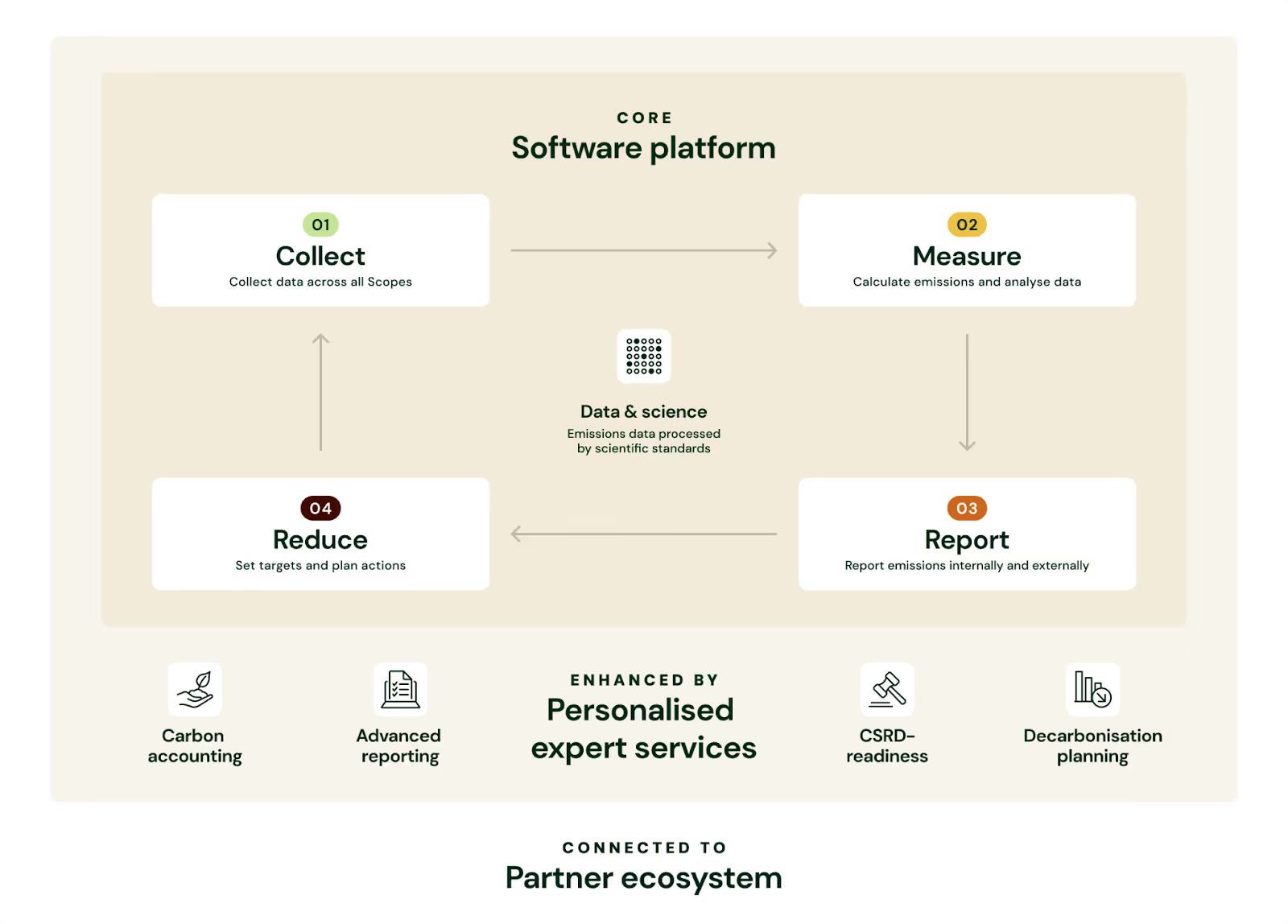Emissions management software is an essential tool for businesses looking to collect, manage and track their emissions and ultimately gain a competitive edge via decarbonisation. As businesses have no choice but to manage and report on their emissions to ensure compliance with stringent sustainability regulations, many companies are simultaneously leveraging emissions management software to gain a strategic advantage in their respective industry.
What is emissions management software?
Emissions management software is a specialised software designed to help organisations track, manage, and reduce their greenhouse gas (GHG) emissions and other environmental impacts. Companies, governmental agencies, and other organisations increasingly leverage emissions management software to ensure compliance with environmental regulations (e.g., the Corporate Sustainability Reporting Directive), undergo sustainable transformation, and achieve sustainability goals. Alternatively, companies may leverage carbon accounting software or sustainability software to achieve their sustainability goals.
8 best emissions management software
1. Plan A
Plan A’s emissions management software is the industry-leading carbon management platform. The comprehensive tool combines corporate carbon accounting, decarbonisation, ESG reporting and sustainability software via one easy-to-use emissions management software. Plan A’s top-rated software is TÜV Rheinland certified and GHG Protocol compliant. Their vast provision of science-based expert support and extensive network of service partners ensure businesses are smoothly and efficiently undergoing sustainable transformation.

Credit: Plan A
Plan A provides a comprehensive carbon analysis that enables businesses to efficiently measure and reduce Scope 1, 2, and 3 emissions, decarbonise operations and value chains, comply with ESG regulations, and communicate performance to internal and external stakeholders. Plan A’s clients, such as N26, BNP Paribas, Chloé, Flix, Sorare, BMW and Trivago are quickly transforming into leaders of tomorrow’s net-zero economy as they are empowered to manage their entire net-zero journey all in one platform via automated CO2 emissions calculation, carbon reduction planning, as well as CSRD management.
2. IBM Envizi
Envizi, recently acquired by IBM, is a comprehensive sustainability and emissions management platform. It enables organisations to capture, track, and manage emissions data across their global operations. Moreover, Envizi offers analytics and reporting tools, assisting companies in meeting their compliance obligations and driving sustainable practices.
3. Microsoft Sustainability Cloud
Microsoft Sustainability Cloud extends Microsoft's commitment to sustainable initiatives. This offering allows companies to document, disclose, and curtail their environmental impact via Microsoft's Sustainability Manager. Microsoft envisions customers leveraging this platform to magnify progress and reshape their business strategies through environmental, social, and governance (ESG) capabilities. While definitive conclusions can not be made, the carbon accounting solution may best suit mid-market and small-to-medium business (SMB) clients.
4. Sphera
Sphera is an ESG performance and risk management-focused software under ‘The Blackstone Group's umbrella’. Sphera approaches emissions management through integration, emphasising organisational safety enhancement and liability reduction to foster trust and cultivate a positive environmental image. Sphera's software aims to dissolve information silos by centralising reporting, data, and management tools whilst facilitating collaborative efforts within teams dedicated to safety and sustainability pursuits.
5. Emex
Emex provides an enterprise-level EHS and ESG software platform with comprehensive emissions management tools. The platform supports the tracking, reporting, and analysing of emissions data, helping organisations reduce their carbon footprint and meet sustainability targets. Emex's software is known for its robust reporting capabilities and user-friendly design.
6. Diligent ESG
Diligent's emissions management software helps organisations manage and report on ESG commitments and performance. It centralises ESG data, enabling companies to monitor and act on ESG risks and comply with evolving regulations and standards. The software includes data collection, dynamic reporting with dashboards, and integration with other governance, risk, and compliance programs. It also supports benchmarking against multiple standards.
7. Salesforce's Net Zero Cloud
Net Zero Cloud by Salesforce is an emissions management platform that leverages Salesforce's automation, language support, and integration features. While such features equip it with valuable emissions reporting capabilities, the platform may be constrained by its reliance on an existing data schema that wasn't inherently designed for accounting purposes, and assessments of its overall scalability have produced mixed results.
8. Intelex
Intelex offers a cloud-based environmental management tool with robust emissions management features. Their platform allows organisations to track emissions from multiple sources, generate compliance reports, and implement strategies to reduce their environmental impact. Intelex is known for its flexibility and user-friendly interface.
6 essential features of emissions management software
When selecting emissions management software, businesses should prioritise features that ensure comprehensive, accurate, and efficient emissions management. The following are six key capabilities that an effective emissions management platform should offer:

How to choose the right emissions management software for your business
Selecting the proper emissions management software is crucial for companies aiming to calculate, manage, and reduce their emissions effectively. When evaluating different options, companies should focus on several key factors to ensure they choose the most suitable solution:
Scopes 1, 2, and 3 emissions coverage: Emissions management software must allow businesses to efficiently and accurately calculate their emissions across their entire value chain, as most emissions are indirect— or Scope 3.
Intuitive data management: Emissions management software should facilitate hassle-free data collection, input, and analysis in one centralised location. Data collection may seem tedious, yet effective carbon accounting software will allow organisations to consolidate their data in one secure platform to gain an accurate insight into the company’s carbon footprint.
Decarbonisation-oriented: Emissions management platforms prioritising decarbonisation help users reduce their emissions effectively and implement reduction pathways. This approach avoids reliance on offsetting or compensating, which can expose businesses to the risks of greenwashing.
Backed by science: Businesses should choose emissions management software that follows a certified methodology, such as the GHG Protocol. This alignment ensures accurate comparison of emissions across all scopes and facilities, helps obtain industry-specific benchmarks, and identifies critical areas for improvement. Additionally, globally recognised certifications like TÜV Rheinland guarantee that the data is accurate and based on solid scientific principles.
ESG and sustainability reporting: Mandatory directives like the CSRD present a significant opportunity for businesses to transform. To meet these new requirements, companies should adopt an emissions management tool that combines advanced accounting and reporting features with expert support and educational resources to ensure regulatory compliance.
Tailored support: Businesses must choose an emissions management software that offers tailored support based on factors influencing the company (e.g., industry, size, geographic location). In doing so, businesses can seamlessly navigate tailored issues such as complex data input and validating science-based targets.
How does emissions management software help companies decarbonise?
Accurate measurement is the foundation of effective emissions management and reduction. Emissions management software plays a crucial role by enabling companies to track, manage, and reduce their emissions precisely. These platforms support businesses in every step of their decarbonisation journey by providing data collection, analysis, reporting, and target-setting tools.
1. Effortlessly collect data across your entire value chain
Emissions management software helps you easily collect and consolidate your emissions data. Time-saving data collection is essential to ensuring emissions management is a value driver rather than a cost factor. Effective emissions management software will enable you to streamline your emissions data and ensure complete data accuracy and transparency across your organisation.

Credit: Plan A
2. Measure your emissions accurately and frequently
Once businesses have efficiently collected accurate and reliable data, emissions management software helps them calculate their carbon footprint and identify their hotspots. Meanwhile, software ensures these measurements are strengthened from an accuracy and frequency standpoint. Effective software is a massive help to internal teams as they can automatically calculate emissions across all scopes and categories under the GHG Protocol and the latest climate science, analyse and compare emissions across facilities, subsidiaries, and business units, and quickly identify hotspots.

Credit: Plan A
3. Effortlessly report your emissions and master your CSRD journey
Once the measurements are complete, businesses can leverage emissions management software to report on carbon emissions and quickly align with CSRD. Leading software such as Plan A’s platform allows you to generate an annual emissions report that outlines your Scope 1, 2, and 3 and shows how you are progressing against your net-zero goals. If you need to report under CSRD, Plan A will further help you navigate through every step of your CSRD journey with tailored support.

Credit: Plan A
4. Set decarbonisation targets using expert guidance
Once the measurement has taken place, emissions management software enables you to set decarbonisation targets that are aligned with science. Robust software will allow you to set science-based targets and break them down into manageable objectives for different scopes or business units. For instance, businesses leverage Plan A’s software platform and engage with experts to define and meet their reduction targets.

Credit: Plan A
5. Leverage tailored reduction levers to decarbonise your operations
Once emissions are measured and decarbonisation targets are set, emissions management software helps you reduce your emissions with tailored action lever recommendations. The software allows businesses to harness a decarbonisation pathway tailored to their requirements. Software such as Plan A will enable you to select and prioritise the actions with the highest reduction potential to achieve your targets.

Credit: Plan A
6. Monitor progress to improve your decarbonisation strategy
Finally, emissions management software enables you to improve your decarbonisation strategy and achieve data-driven sustainability. Businesses can leverage software to ensure ongoing emissions monitoring, that the company is on track to reach its sustainability goals, and that it refines its strategy if necessary. Businesses can safeguard their companies by reducing carbon emissions and adopting decarbonisation plans as our global economy transitions to net-zero.

Effective emissions management is essential for regulatory compliance and gaining a competitive edge in sustainability. The eight emissions management software solutions featured in this article demonstrate the innovative approaches and basic tools needed to manage environmental impact effectively. These platforms offer a range of capabilities, from detailed carbon accounting and strategic decarbonisation planning to advanced reporting features. Together, they supply organisations with the resources to accurately track, manage, and reduce their emissions, ensuring they meet regulatory requirements and drive sustainable growth.
Schedule a call with Plan A today to accelerate your decarbonisation journey.



.jpg)

.webp)



